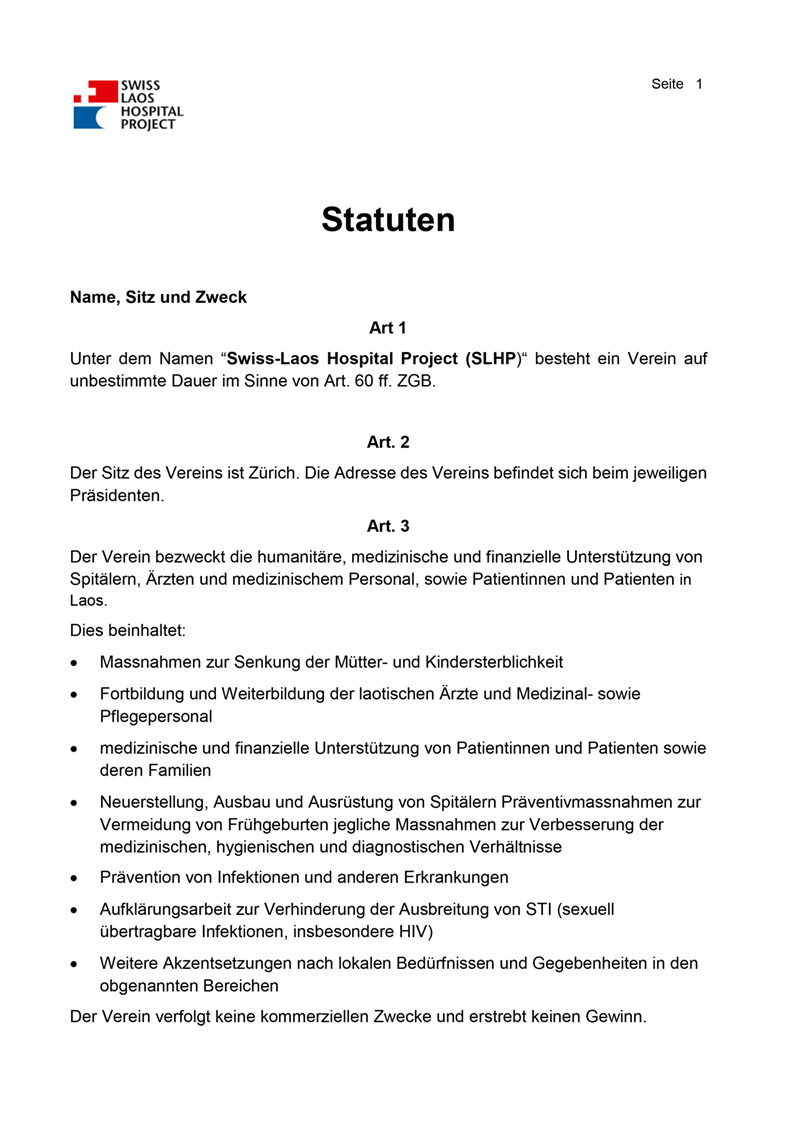
The bylaws of the Swiss Laos Hospital Project
Version of 30 May 2016
THIS ENGLISH TRANSLATION IS PROVIDED FOR YOUR CONVENIENCE. LEGALLY BINDING IS THE GERMAN ORIGINAL ALONE.
Name, Seat and Purpose
Art. 1
Under the name «Swiss-Laos Hospital Project (SLHP)», an association («Verein») exists for an indefinite period of time according to art. 60 ff. of the Swiss civil code («ZGB»).
Art. 2
The seat of the association is Zurich. The address of the association corresponds with the address of its president.
Art. 3
The purpose of the association is the humanitarian, medical and financial support of hospitals, doctors and medical staff as well as patients in Laos.
This includes:
- Measures to reduce maternal and child mortality
- Further education and training of Lao doctors as well as medical and nursing staff
- medical and financial support for patients and their families
- New construction, expansion and equipping of hospitals
- Preventive measures to avoid premature births
- Any measures to improve medical, hygienic and diagnostic conditions
- Prevention of infections and other diseases
- Raising awareness to prevent the spread of STIs (sexually transmitted infections, especially HIV)
- Further efforts according to local needs and conditions in the above-mentioned areas
The association does not pursue commercial purposes and does not aim to make a profit.
Membership
Art. 4
Any natural and legal person who supports the objectives of the association can become a member.
The association consists of active members, honorary members and passive members, the latter without voting and election rights.
The membership fees are determined in the general assembly. Honorary members are exempt from the fees.
Art. 5
The application for admission to the association can be submitted in writing to the board at any time. Requests for resignation must be submitted in writing to the board at the end of a calendar year with three months‘ notice. Any liabilities to the Association must be settled in advance.
A member can be excluded at any time without giving reasons. The exclusion becomes effective if the expelled member does not file a written appeal to the general assembly within 30 days after receipt of the written notification by the board. In this case, the general assembly of the association will make the final decision on the exclusion. The expelled person must be heard by the general assembly.
Art. 6
For the debts of the association only the assets of the association are liable. A personal liability of the members is excluded.
Organization
Art. 7
The bodies of the association are:
- the general assembly
- the board
- the auditors
The two latter bodies are each elected for two years at the ordinary general assembly of the association. A re-election is permitted.
The General Assembly
Art. 8
The regular general assembly takes place every year after completion of the financial year, at the latest in June.
Motions from members for the attention of the ordinary general assembly must be submitted in writing, with a brief explanation, to the board by 31 December.
The proposals must be included on the agenda.
An extraordinary general assembly can be held at any time by resolution of the board. In addition, 1/5 of the members have the right to request the board to convene an extraordinary general assembly at any time. Such a request must be fulfilled within 2 months.
Invitations must be sent to all members at least 20 days before the ordinary or extraordinary general assembly, stating the items on the agenda.
The president is usually the chairman of the general meeting. Minutes are to be taken of the association meeting.
Art. 9
The ordinary or extraordinary general assembly has the following competences:
a) Approval of the minutes, the annual report and the annual financial statements
b) Election of the president and all other members of the board
c) Election of the auditors (auditors of accounts)
d) Approval of the budget for the following year
e) Determination of the membership fees
f) Changes to the bylaws
g) Approval of guidelines and regulations
h) Decisions on motions from members of the association
i) Decisions on appeals regarding the exclusion of a member
j) Merger or dissolution of the association
k) Dismissal of the other organs for good cause
Art. 10
Each member of the association has one vote at the association meeting. The General Assembly passes its resolutions and carries out its elections by a simple majority of the votes cast, unless the statutes stipulate otherwise.
If, in elections in a first ballot, candidates do not achieve a simple majority of the votes cast, the relative majority shall decide in a second ballot.
All votes and elections must be held openly. 1/5 of the members present may demand a secret ballot.
In case of a tie, the chairman has the casting vote.
The Board
Art. 11
The board consists of 7 to 9 active members. The president and all other board members are elected by the general meeting for a period of two years.
The board constitutes itself.
The members of the board work in an honorary capacity and are generally only entitled to compensation for their actual expenses and cash payments. Appropriate compensation may be paid for special services rendered by individual members of the board.
Art. 12
The board manages and administers the association and represents it externally. It is entitled to all powers which are not assigned to another organ of the association by the statutes or by law.
Commissions or delegations may be appointed for special tasks.
The president, together with another member of the executive committee, provides the legally binding collective signature for the association.
Art. 13
Board meetings are held at the request of the president or two other board members.
Board meetings must be recorded in minutes.
Art. 14
The presence of a majority of the board is required for a quorum. Resolutions are passed by a simple majority. The chairman has a vote and has the casting vote in case of a tie.
Decisions may also be taken by circular letter.
Art. 15
The president runs board meetings as well as ordinary and extraordinary general meetings. He ensures that the decisions are implemented.
Art. 16
The vice president replaces the president in case of prevention.
Art. 17
The actuary, in cooperation with the treasurer, keeps a membership register and usually handles correspondence. He keeps the minutes of the board meetings and the general meetings.
Art. 18
The treasurer takes care of all accounting. He/she prepares the annual accounts and the budget, which are discussed and approved by the board and then submitted to the ordinary general assembly.
Auditors
Art. 19
One or two auditors elected by the general assembly shall exercise control over the accounts and shall submit a written report to the general assembly for discharge.
Funds of the Association
Art. 20
The funds of the association consist of:
a) The annual membership fees
b) Endowments, bequests and monetary donations
c) Beneficial contributions of all kinds
The achievement of a profit is not intended. Any net income is to be carried over to the following year of the association. A distribution of the net income among the members is excluded.
Financial Year
Art. 21
The financial year begins on 1 January and ends on 31 December of the current year.
Revision of the Bylaws
Art. 22
An amendment to these bylaws can only be decided by the ordinary general meeting and must be announced in the invitation. The intended changes to the statutes are to be sent to the members with the invitation to the ordinary general meeting.
A two-thirds majority of the votes cast is required for adoption.
Dissolution and Merger
Art. 23
The dissolution or merger of the association can only be decided by a two-thirds majority of all members.
Art. 24
The assets of the association remaining after the dissolution of the association and after the settlement of all liabilities are to be used exclusively for charitable purposes.
Adopted by the general meeting on 30.5.2016
Prof. Hans Ulrich Bucher, president

